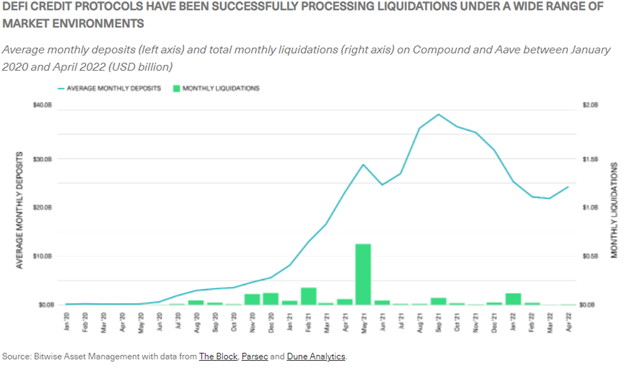“The Ground Shook, And the Foundation Held” – Bitwise on DeFi
Decentralized finance (DeFi) is still a newer entrant to the schoolyard of finance, but if it’s anything, it’s the up-and-coming scrappy fighter that learns from its knockdowns, goes home, and instead of sulking it does the work to improve, coming back smarter, stronger, more resilient, and more robust than ever. That’s according to Bitwise, which took a look into the very overlooked resiliency that the DeFi market has displayed recently, even through the Terra UST/Luna crash.
The DeFi credit markets are one of the largest sectors in crypto today, at a combined market cap of $8.5 billion and greater than $50 billion in total deposits, but it has taken work and hard lessons learned to get to the point it is now.
DeFi allows investors to create yield from their crypto assets, whether cryptocurrencies or otherwise, by earning interest on crypto assets deposited with a protocol like Compound. Within the DeFi credit market, investors will deposit their cryptocurrencies into a “lending pool,” and those pools are used to collateralize borrowing stablecoins.
The onset of the pandemic in 2020 that saw all asset classes plummet had a heavy impact on crypto in particular since it is considered by some to be one of the riskiest of the risk assets. Prices of all of the biggest crypto assets dropped drastically, and volume spiked on the decentralized protocols, causing liquidations to the tune of millions of dollars as the lending protocols failed.
It’s something that the biggest DeFi players set about addressing and preventing from ever happening again.
“The leading players persevered and implemented lessons learned, becoming more sophisticated than ever in managing risk and optimizing for growth and resilience. As a result, a categorical transformation is underway in a system that is focused on fine-tuning stability and scalability,” the authors of the Bitwise paper wrote.

Image source: Bitwise
The two lending protocols, Aave and Compound, have been put through their paces since then; in May 2021, ETH dropped 41% in a single day, and both protocols processed $330 million in liquidations in a day, with more than 100x the assets that prompted the crash in March of 2020 with no meaningful insolvencies.
DeFi Performance During the UST Crash
I was interested in finding out how Compound and Aave had performed in the rash of sell-offs that occurred around the time of UST’s collapse, so I asked Bitwise for some follow-up.
“We had a $60b blowup, and the system cleared. There was no bailout, no cascade of failed liquidations. The ground shook, and the foundation held. That’s worth noting,” Ryan Rasmussen, DeFi research analyst at Bitwise, said in a communication to VettaFi.
It turns out that DeFi remained resilient and robust even amid the market panic. Since its crash in 2020, a whole host of parameters and tools have been implemented, including collateral factors, interest rate models for each lending pool, reserve factors, and more.
“Gauntlet’s analysis of on-chain activity between May 9th and May 12th found that Aave and Compound operated smoothly during the recent market sell-off and demise of UST/LUNA. Both protocols experienced no material insolvencies (the ones that did occur were across dust accounts, meaning the cost of liquidating was more than the profit for liquidators because the amount was so small),” Rasmussen explained.
So what of stablecoins? What got crypto into this whole mess in the first place, or at least this most recent mess? Well, it’s not stablecoins that are the issue per se, but instead that subset of stablecoins that are based on algorithms without any real-world collateral to back them, and that’s exactly what was seen in the market. There was panic surrounding UST losing its peg to the dollar and the subsequent implosion of UST and its sister token Luna, and that fear passed temporarily into other stablecoins like Tether, which briefly dipped below its $1 peg before recovering.
“Undercollateralized (or algorithmic) stablecoins have yet to prove their staying power. But other stablecoins that are over-collateralized (e.g., DAI) or fiat-backed (e.g., USDC) have been around for years,” Rasmussen said. “They are promising — and thus far resilient — applications of the innovations of crypto and blockchain technology.”
Bitwise offers the Bitwise Crypto Industry Innovators ETF (BITQ), the Bitwise 10 Crypto Index Fund (BITW), and a host of other crypto funds focusing on various aspects of the crypto economy.
For more news, information, and strategy, visit the Crypto Channel.
The views and opinions expressed herein are the views and opinions of the author and do not necessarily reflect those of Nasdaq, Inc.


